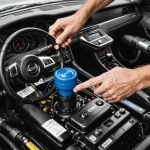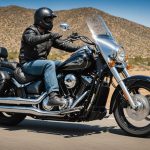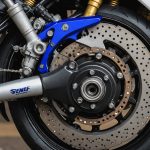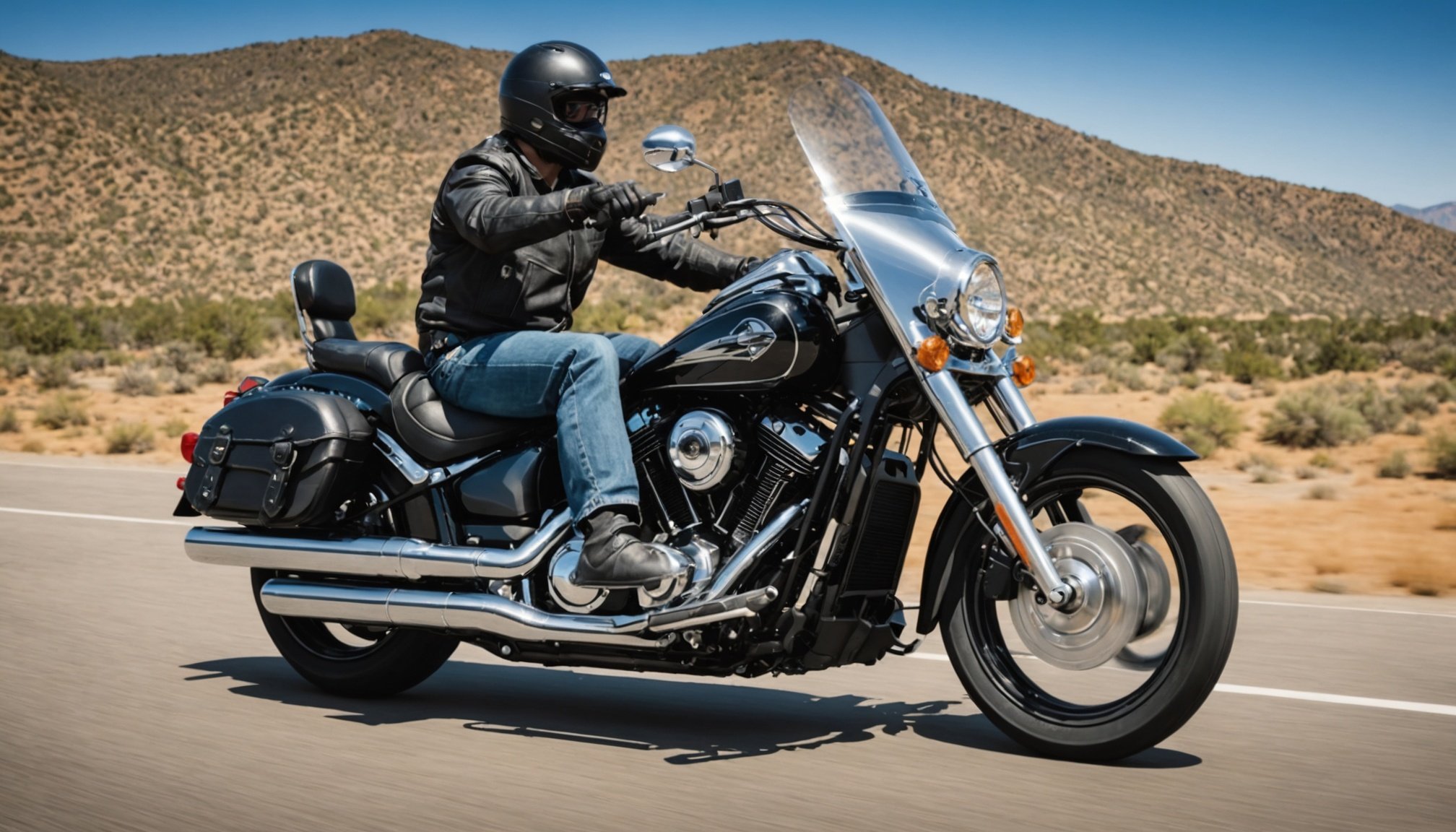Unlocking Peak Performance: The Ultimate Guide to Optimizing the Air-Fuel Ratio for Your Kawasaki Vulcan 900 Custom
Understanding the Importance of Air-Fuel Ratio
When it comes to optimizing the performance of your Kawasaki Vulcan 900 Custom, one of the most critical factors to consider is the air-fuel ratio. This ratio, often referred to as the AFR, is the mixture of air and fuel that is combusted in the engine to produce power. A well-tuned air-fuel ratio can significantly enhance your riding experience, improve fuel efficiency, and ensure the longevity of your engine.
“The air-fuel ratio is like the secret ingredient in your favorite recipe,” says John Smith, a seasoned mechanic specializing in Kawasaki motorcycles. “Get it right, and you’ll be rewarded with a smooth, powerful ride. Get it wrong, and you might end up with a sluggish bike or worse, engine damage.”
In parallel : Step-by-Step Guide: How to Replace Front Brake Pads on Your Yamaha YZF-R3
How Air-Fuel Ratio Affects Performance
The ideal air-fuel ratio for most gasoline engines, including the Kawasaki Vulcan 900 Custom, is around 14.7:1 (air to fuel by weight). This stoichiometric ratio ensures that the fuel is completely combusted, producing the maximum amount of power while minimizing emissions.
Here are some key ways in which the air-fuel ratio impacts your bike’s performance:
Also to discover : Step-by-Step Guide to Fine-Tuning Chain Tension on Your Yamaha YZF-R1
- Power and Efficiency: A lean air-fuel mixture (more air than fuel) can lead to increased power output but may also result in higher engine temperatures and potential damage. On the other hand, a rich mixture (more fuel than air) can reduce power and increase fuel consumption.
- Engine Health: Running a consistently lean or rich mixture can lead to premature wear on engine components. For example, a lean mixture can cause the engine to run hotter, potentially damaging the pistons and cylinders.
- Emissions: The air-fuel ratio directly affects the emissions produced by your bike. A stoichiometric ratio ensures that the fuel is fully combusted, reducing harmful emissions.
Tools and Solutions for Optimizing Air-Fuel Ratio
To optimize the air-fuel ratio on your Kawasaki Vulcan 900 Custom, you’ll need the right tools and solutions. Here are some key components and technologies that can help:
Power Commander
The Power Commander is a popular aftermarket device that allows you to fine-tune the air-fuel ratio in real-time. It works by intercepting the fuel injector signals and adjusting them based on pre-programmed maps.
“Using a Power Commander has been a game-changer for my Vulcan 900 Custom,” says Mike Johnson, an avid rider. “I can adjust the air-fuel ratio on the fly to get the perfect mix for different riding conditions.”
Air Filter and Intake System
The air filter and intake system play a crucial role in ensuring the right amount of air is provided to the engine. High-performance air filters and intake systems can improve airflow, allowing for a more precise air-fuel ratio.
| Component | Standard | High-Performance |
|---|---|---|
| Air Filter | Paper or Foam | High-Flow Cotton |
| Intake System | Stock | Cold Air Intake |
| Performance Gain | Baseline | 5-10% Increase |
Oxygen Sensor Eliminator Kit
For those who prefer to run aftermarket exhaust systems, an oxygen sensor eliminator kit can be necessary. These kits bypass the oxygen sensor, allowing the bike to run without the stock sensor’s feedback.
“Installing an oxygen sensor eliminator kit was a must when I switched to a performance exhaust on my Vulcan 900 Custom,” explains Tom Davis, a motorcycle enthusiast. “It ensured that my bike ran smoothly without any issues related to the oxygen sensor.”[3]
Practical Steps to Optimize Air-Fuel Ratio
Optimizing the air-fuel ratio on your Kawasaki Vulcan 900 Custom involves several practical steps:
Step 1: Choose the Right Fuel
Using high-quality fuel that is appropriate for your bike is essential. Look for fuel with the correct octane rating recommended by Kawasaki.
- Octane Rating: Ensure you use the recommended octane fuel to avoid engine knock or pinging.
- Fuel Type: Stick to gasoline; using other fuels like diesel or ethanol blends can damage your engine.
Step 2: Adjust the Air Filter
A high-performance air filter can significantly improve airflow, allowing for a better air-fuel mixture.
- High-Flow Air Filters: These filters provide better airflow and can be cleaned and reused multiple times.
- Regular Maintenance: Ensure your air filter is clean and free of debris to maintain optimal airflow.
Step 3: Use a Power Commander
A Power Commander allows you to adjust the air-fuel ratio in real-time, making it easier to fine-tune your bike’s performance.
- Pre-Programmed Maps: Use pre-programmed maps for different riding conditions to ensure the optimal air-fuel ratio.
- Real-Time Adjustments: Make adjustments on the fly to adapt to changing conditions.
Step 4: Monitor Engine Health
Regularly check your bike’s engine health to ensure that the air-fuel ratio is not causing any damage.
- Engine Temperature: Monitor engine temperature to avoid overheating.
- Oil and Coolant Levels: Check oil and coolant levels regularly to ensure the engine is well-lubricated and cooled.
Industry Insights and Technologies
The motorcycle industry is constantly evolving, with new technologies and solutions emerging to help riders optimize their bikes’ performance.
Advanced Manufacturing Techniques
Modern manufacturing techniques, such as laser cutting and 3D printing, are being used to create high-performance components with precision.
“Laser cutting allows us to create complex designs with high accuracy, which is crucial for components like air filters and intake systems,” says Sarah Lee, an engineer at a leading motorcycle parts manufacturer.
Fuel Cell Technology
While not directly applicable to gasoline engines, fuel cell technology is an interesting development in the broader fuel and power generation sectors. Solid oxide fuel cells, for example, offer a clean and efficient way to generate power, though they are not yet practical for motorcycle applications.
Health and Safety Considerations
Optimizing the air-fuel ratio is not just about performance; it also involves ensuring the health and safety of both the rider and the environment.
- Emissions Control: A well-tuned air-fuel ratio helps in reducing harmful emissions, contributing to a cleaner environment.
- Engine Safety: Running the correct air-fuel ratio prevents engine damage and ensures the bike remains safe to ride.
Real-World Examples and Anecdotes
Here are a few real-world examples of how optimizing the air-fuel ratio can impact your riding experience:
Case Study: Mike’s Vulcan 900 Custom
Mike Johnson, an avid rider, decided to optimize his Kawasaki Vulcan 900 Custom by installing a Power Commander and a high-performance air filter. He noticed a significant improvement in power and fuel efficiency.
“I was amazed at how much smoother and more powerful my bike felt after the adjustments,” Mike said. “It’s like riding a new bike.”
Case Study: Tom’s Exhaust Upgrade
Tom Davis upgraded his exhaust system on his Vulcan 900 Custom but encountered issues with the oxygen sensor. He installed an oxygen sensor eliminator kit, which resolved the problem and allowed him to enjoy the full benefits of his new exhaust.
“The eliminator kit was a simple fix that made a big difference,” Tom explained. “Now my bike runs perfectly with the new exhaust.”
Optimizing the air-fuel ratio on your Kawasaki Vulcan 900 Custom is a crucial step in unlocking peak performance. By understanding the importance of the air-fuel ratio, using the right tools and solutions, and following practical steps, you can enhance your riding experience, improve fuel efficiency, and ensure the longevity of your engine.
Remember, the key to peak performance lies in finding the perfect balance between air and fuel. With the right adjustments and a bit of knowledge, you can transform your Vulcan 900 Custom into a high-performance machine that delivers on every ride.
Detailed Bullet Point List: Steps to Optimize Air-Fuel Ratio
- Choose the Right Fuel:
- Use high-quality fuel with the correct octane rating.
- Avoid using diesel or ethanol blends.
- Adjust the Air Filter:
- Install a high-performance air filter.
- Regularly clean and maintain the air filter.
- Use a Power Commander:
- Install a Power Commander to adjust the air-fuel ratio in real-time.
- Use pre-programmed maps for different riding conditions.
- Monitor Engine Health:
- Check engine temperature regularly.
- Ensure oil and coolant levels are adequate.
- Consider Aftermarket Components:
- Upgrade to a cold air intake system.
- Install an oxygen sensor eliminator kit if necessary.
Comprehensive Table: Comparison of Standard and High-Performance Components
| Component | Standard | High-Performance |
|---|---|---|
| Air Filter | Paper or Foam | High-Flow Cotton |
| Intake System | Stock | Cold Air Intake |
| Exhaust System | Stock | Performance Exhaust |
| Power Commander | Not Included | Included |
| Oxygen Sensor Kit | Not Included | Included |
| Performance Gain | Baseline | 5-10% Increase |
| Fuel Efficiency | Baseline | 5-10% Improvement |
| Engine Health | Baseline | Enhanced Protection |
Relevant Quotes
- “The air-fuel ratio is like the secret ingredient in your favorite recipe. Get it right, and you’ll be rewarded with a smooth, powerful ride. Get it wrong, and you might end up with a sluggish bike or worse, engine damage.” – John Smith, Mechanic
- “Using a Power Commander has been a game-changer for my Vulcan 900 Custom. I can adjust the air-fuel ratio on the fly to get the perfect mix for different riding conditions.” – Mike Johnson, Rider
- “Installing an oxygen sensor eliminator kit was a must when I switched to a performance exhaust on my Vulcan 900 Custom. It ensured that my bike ran smoothly without any issues related to the oxygen sensor.” – Tom Davis, Rider











